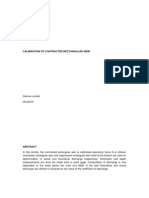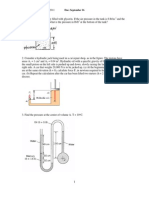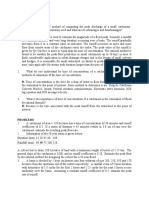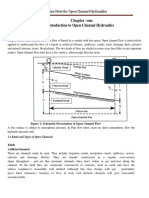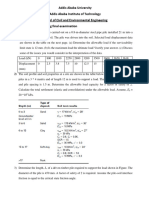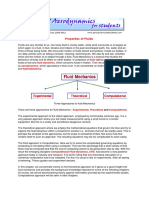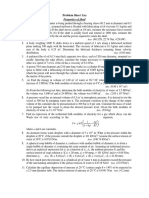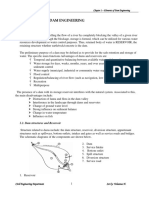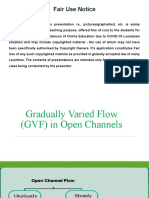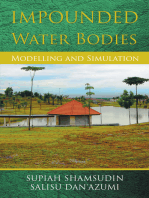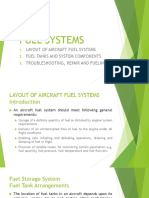Ceng 231 Tutor 1
Ceng 231 Tutor 1
Uploaded by
lawekushCopyright:
Available Formats
Ceng 231 Tutor 1
Ceng 231 Tutor 1
Uploaded by
lawekushOriginal Description:
Copyright
Available Formats
Share this document
Did you find this document useful?
Is this content inappropriate?
Copyright:
Available Formats
Ceng 231 Tutor 1
Ceng 231 Tutor 1
Uploaded by
lawekushCopyright:
Available Formats
18/7/2014
CENG 231 Tutor 1
CENG 231 Process Fluid Mechanics
Tutorial Examples 1
1. A hydraulic ram 200 mm in diameter and 1.2 m long moves wholly within a concentric cylinder 200.2 mm in
diameter, and the annular clearance is filled with oil of relative density 0.85 and kinematic viscosity 400 mm2 / s.
What is the viscous force resisting the motion when the ram moves at 120 mm / s?
( Ans.: 307.6 N )
2. The space between two large flat and parallel walls 25 mm apart is filled with a liquid of absolute viscosity 0.7 Pa
s. Within this space a thin flat plate, 250 mm x 250 mm is towed at a velocity of 150 mm / s at a distance of 6 mm
from one wall, the plate and its movement being parallel to the walls. Assuming linear variations of velocity between
the plate and the walls, determine the force exerted by the liquid on the plate.
( Ans.: 1.493 N )
3. Calculate the pressure in the ocean at a depth of 2000 m assuming that salt water is (a) incompressible with a
constant density of 1002 kg / m3, (b) compressible with a bulk modulus of 2.05 GN / m2 and a density at the surface
of 1002 kg / m3.
( Ans.: 19.66 MN / m2, 19.75 MN / m2 )
4. Show that the ratio of the pressures (p2 / p1) and densities (r2 / r1) for altitudes h2 and h1 in an isothermal
atmosphere is given by
What increase in altitude is necessary in the stratosphere to halve the pressure? Assume a constant temperature of
-56.5 o C and the gas constant R = 287 J / kg K.
( Ans.: 4390 m )
5. Two small vessels are connected to a U-tube manometer containing mercury (relative density 13.56) and the
connecting tubes are filled with alcohol (relative density 0.82). The vessel at the higher pressure is 2 m lower in
elevation than the other. What is the pressure difference between the vessels when the steady difference in level of the
mercury menisci is 225 mm? What is the difference of piezometric head? If an inverted U-tube manometer containing
a liquid of relative density 0.74 were used instead, what would be the manometer reading for the same pressure
difference?
(Ans. : 44.2 kPa,3.495m, 35.82 m)
6. A manometer consists of two tubes A and B, with vertical axes and uniform cross-sectional areas 500 mm2 and
800 mm2 respectively, connected by a U-tube C of cross-sectional area 70 mm2 throughout. Tube A contains a
liquid of relative density 0.8; tube B contains one of relative density of 0.9. The surface of separation between the
two liquids is in the vertical side of C connected to tube A. Determine the additional pressure which, when applied to
the tube B, will cause the surface of separation to rise 60 mm in the tube C.
http://home.ust.hk/~kepgao/CENG231/Tutor1/tutor1.htm
1/11
18/7/2014
CENG 231 Tutor 1
( Ans.: 171.1 Pa )
7. An oil and mercury manometer consists of a U-tube 5 mm diameter with both limbs vertical. The right-hand limb is
enlarged at its upper end to 25 mm diameter. The enlarged end contains oil with its free surface in the enlarged
portion and the surface of separation between mercury and oil is below the enlarged end. The left-hand limb contains
mercury only, its upper end being open to the atmosphere. The right-hand side is connected to a vessel containing
gas under pressure and the surface of separation is observed to fall 2 cm. Calculate the pressure of the gas in N / m2
if the specific gravity of mercury and oil are 13.6 and 0.85 respectively. The surface of the oil remains in the enlarged
ends.
(Ans.: 5.17x 103N/m2)
8. A manometer consists of an inclined glass tube which is connected to a meter cylinder standing upright: liquid fills
the apparatus to a fixed zero mark on the tube when both cylinder and tube are open to the atmosphere. The upper
end of the cylinder is then connected to a gas supply at a pressure p and the liquid rises in the tube. Find an
expression for the pressure p in cm of water when the liquid reads y cm in the tube, in terms of inclination q of the
tube, the specific gravity of the liquid s, and the ratio r of the diameter of the cylinder to the diameter of the tube.
Hence determine the value of r so that the error due to disregarding the change in level in the cylinder will not exceed
0.1 % when q = 30 .
(Ans. :44.7)
9. An inclined manometer is required to measure an air pressure difference of about 3 mm of water with an accuracy
of 3 %. The inclined arm is 8 mm diameter and the enlarged end is 24 mm diameter. The density of the manometric
fluid is 740 kg / m3. Find the angle which the inclined arm must make with the horizontal to achieve the required
accuracy assuming that the scale can be read with a maximum error of 0.5 mm.
( Ans.: 735' )
10. A manometer consists of a U-tube of diameter d, the upper part of each limb enlarged to diameter D. The small
tube contains liquid of relative density sm and on top of this in each limb is a liquid of relative density s. The free
surfaces are in the enlarged parts and the surfaces of separation between the two liquids of density sm and s are in the
small tube and initially level. Show that the pressure difference in a gas which, when applied across the manometer,
produces a difference in the interface levels of h in the small tube is given by
r - density of water
where the free surfaces remain in the enlarged ends. Also show that the sensitivity becomes greatest when the value
of s approaches sm.
In such a manometer the ratio D / d = 5, one of the manometer liquids is water and the other of relative density 0.95.
Find the applied pressure difference required to produce a difference of interface levels h of 1 cm.
( Ans.: 8.63 Pa )
11. A spherical air bubble rises in water. At a depth of 9m its diameter is 4mm. What is its diameter just as it reaches
the free surface where the pressure is 101.3 kPa? You may assume that surface tension effects are negligible.
http://home.ust.hk/~kepgao/CENG231/Tutor1/tutor1.htm
2/11
18/7/2014
CENG 231 Tutor 1
( Ans.: 4.93 mm )
http://home.ust.hk/~kepgao/CENG231/Tutor1/tutor1.htm
3/11
18/7/2014
http://home.ust.hk/~kepgao/CENG231/Tutor1/tutor1.htm
CENG 231 Tutor 1
4/11
18/7/2014
http://home.ust.hk/~kepgao/CENG231/Tutor1/tutor1.htm
CENG 231 Tutor 1
5/11
18/7/2014
http://home.ust.hk/~kepgao/CENG231/Tutor1/tutor1.htm
CENG 231 Tutor 1
6/11
18/7/2014
http://home.ust.hk/~kepgao/CENG231/Tutor1/tutor1.htm
CENG 231 Tutor 1
7/11
18/7/2014
http://home.ust.hk/~kepgao/CENG231/Tutor1/tutor1.htm
CENG 231 Tutor 1
8/11
18/7/2014
http://home.ust.hk/~kepgao/CENG231/Tutor1/tutor1.htm
CENG 231 Tutor 1
9/11
18/7/2014
http://home.ust.hk/~kepgao/CENG231/Tutor1/tutor1.htm
CENG 231 Tutor 1
10/11
18/7/2014
http://home.ust.hk/~kepgao/CENG231/Tutor1/tutor1.htm
CENG 231 Tutor 1
11/11
You might also like
- EsubieDocument7 pagesEsubieComputer Maintainance Hardware and softwareNo ratings yet
- CEE4476B Assignment 2Document2 pagesCEE4476B Assignment 2Karla Isabel Salgado SánchezNo ratings yet
- Lab #2: Hydrostatic Pressure: Section 5, Group 25Document15 pagesLab #2: Hydrostatic Pressure: Section 5, Group 25Jamilya SoneExolNo ratings yet
- EDG Electrical Test Checklist 2Document26 pagesEDG Electrical Test Checklist 2En FaizulNo ratings yet
- Addis Ababa Science and Technology University College of Biological and Chemical Engineering Department of Environmental EngineeringDocument17 pagesAddis Ababa Science and Technology University College of Biological and Chemical Engineering Department of Environmental EngineeringNatnael workuNo ratings yet
- Relative Equilibrium of LiquidsDocument18 pagesRelative Equilibrium of LiquidsIrene Grace BatalaoNo ratings yet
- Assignment 2Document3 pagesAssignment 2SemNo ratings yet
- Fluid Mechanicsunit 1Document31 pagesFluid Mechanicsunit 1srajubasavaNo ratings yet
- Assignment 2 - 2Document2 pagesAssignment 2 - 2Alexander MugabeNo ratings yet
- Lecture 200999Document22 pagesLecture 200999Sidney MusondaNo ratings yet
- Fluid Mechanics IIIDocument93 pagesFluid Mechanics IIIRanjeet Singh0% (1)
- Topic 7.10 Fluid Flow MeasurementDocument36 pagesTopic 7.10 Fluid Flow MeasurementVERGIE GALVENo ratings yet
- Chapter 6Document31 pagesChapter 6Camille LardizabalNo ratings yet
- Calibration of Contracted Rectangular WeirDocument9 pagesCalibration of Contracted Rectangular WeirDianne Ilao LondobNo ratings yet
- HW3Document3 pagesHW3Giovanni JuarezNo ratings yet
- Pplication of The Bernoulli Equation: Go Back To The Main Index PageDocument11 pagesPplication of The Bernoulli Equation: Go Back To The Main Index Page123habib123fikri100% (1)
- Tutorial Problems in Open ChannelsDocument1 pageTutorial Problems in Open ChannelsTshepho Ketshepha KeisangNo ratings yet
- Chapter 6Document21 pagesChapter 6Shida ShidotNo ratings yet
- War 2103 PrecipitationDocument52 pagesWar 2103 PrecipitationEgana IsaacNo ratings yet
- LATERAL PRESSURE ProblemsDocument65 pagesLATERAL PRESSURE ProblemsAjay JessaniNo ratings yet
- Tarea Runoff-Precipitation-FloodDocument3 pagesTarea Runoff-Precipitation-FloodChristian GarciaNo ratings yet
- ETD Chapter 2Document18 pagesETD Chapter 2Vasantha SeelanNo ratings yet
- 4 - ENS6148 - Descriptive Practice QuestionsDocument3 pages4 - ENS6148 - Descriptive Practice QuestionssatheeswaranNo ratings yet
- Assessment Exam 03Document12 pagesAssessment Exam 03TachooNo ratings yet
- Determination of Fineness of Cement by Dry SievingDocument2 pagesDetermination of Fineness of Cement by Dry SievingMaterial LabNo ratings yet
- Topic - 7 - Permeability & SeepageDocument32 pagesTopic - 7 - Permeability & Seepagejimmys45No ratings yet
- Experiment 3-Unit WeightDocument7 pagesExperiment 3-Unit WeightkauskakiNo ratings yet
- ENSC 16 Problem Set 1Document3 pagesENSC 16 Problem Set 1Mark Raymond Condz LindioNo ratings yet
- MIDTERM CE2231 Hydraulics ModuleDocument36 pagesMIDTERM CE2231 Hydraulics ModuleREYVINSON RAGUDONo ratings yet
- Chapter - One Introduction To Open Channel HydraulicsDocument8 pagesChapter - One Introduction To Open Channel Hydraulicsሽታ ዓለሜNo ratings yet
- Factors Influencing Hydraulic Phenomena: Inertia Force, Mass AccelerationDocument13 pagesFactors Influencing Hydraulic Phenomena: Inertia Force, Mass AccelerationBin IqbalNo ratings yet
- Project On GED IIDocument4 pagesProject On GED IIakhjazrNo ratings yet
- Thin and Thick-Walled Stress Analysis of Pressure VesselDocument31 pagesThin and Thick-Walled Stress Analysis of Pressure VesselSaidFerdjallahNo ratings yet
- InfiltrationDocument16 pagesInfiltrationEdgar Cyrelle EscritorNo ratings yet
- Soil Slope Stability Analysis: 6, Chapter 13 JDocument35 pagesSoil Slope Stability Analysis: 6, Chapter 13 JgayathryNo ratings yet
- FM Mod4@Azdocuments - inDocument17 pagesFM Mod4@Azdocuments - inVivek Thakur Sujanian100% (1)
- 01 - Properties of Fluids PDFDocument11 pages01 - Properties of Fluids PDFHyvemperorNo ratings yet
- Sheet 01 20-21 Properties of Fluid RevDocument2 pagesSheet 01 20-21 Properties of Fluid RevBibaswan MukherjeeNo ratings yet
- Solved Problems and Questions On Fluid Properties: Solution: The Dimensions of These Variables Are (Document6 pagesSolved Problems and Questions On Fluid Properties: Solution: The Dimensions of These Variables Are (محمد عليNo ratings yet
- Chapter 4 Flow Measurement and Bernoulli EquationDocument62 pagesChapter 4 Flow Measurement and Bernoulli Equationaddibzkr100% (1)
- Asgn Water BudgetDocument1 pageAsgn Water BudgetSyed Muhammad MohsinNo ratings yet
- Ch-1, Elements of Dam EngineeringDocument19 pagesCh-1, Elements of Dam EngineeringHenok Alemayehu0% (1)
- DLSUD Soil Mechanics Lab ManualDocument49 pagesDLSUD Soil Mechanics Lab ManualblehNo ratings yet
- Hydrostatic Pressure Plane SurfaceDocument5 pagesHydrostatic Pressure Plane SurfaceAmmir HakimNo ratings yet
- Tutorial 3 (Pressure and Fluid Static) PDFDocument3 pagesTutorial 3 (Pressure and Fluid Static) PDFAnson NaiNo ratings yet
- Assignment Problems (LSD-method, RC-I) : MM N F M KNDocument5 pagesAssignment Problems (LSD-method, RC-I) : MM N F M KNTemesgen100% (4)
- Irrigation EngineeringDocument18 pagesIrrigation EngineeringUmar NaveedNo ratings yet
- Hydraulic - Chapter 2 - Resistance in Open ChannelsDocument31 pagesHydraulic - Chapter 2 - Resistance in Open ChannelsRosdianah RamliNo ratings yet
- Lec#2-4 GVF With SolutionsDocument76 pagesLec#2-4 GVF With Solutionsjonk smithNo ratings yet
- Mechanics of Fluids Problem Set On Total Hydrostatic Force, Dams Ad Buoyancy Identification: Due Date: July 7, 2020Document3 pagesMechanics of Fluids Problem Set On Total Hydrostatic Force, Dams Ad Buoyancy Identification: Due Date: July 7, 2020Mpgmhl C John LyndonNo ratings yet
- Fluid Mechanics EquationsDocument13 pagesFluid Mechanics EquationsBhushan VermaNo ratings yet
- Republic of The Philippines Batangas State University: HydrologyDocument2 pagesRepublic of The Philippines Batangas State University: HydrologyDaryll Gamboa100% (1)
- Topic 8 - EarthworksDocument7 pagesTopic 8 - EarthworksNicholas Bonn SingNo ratings yet
- Applied Hydraulic Engineering: A Course Material OnDocument91 pagesApplied Hydraulic Engineering: A Course Material Onfarag alhassiNo ratings yet
- Lecture 3 - Rainfall Abstraction Computation - Rainfall Abstraction ComputationDocument33 pagesLecture 3 - Rainfall Abstraction Computation - Rainfall Abstraction ComputationNavjotSinghNo ratings yet
- Phase Relation of Soils: Index Properties of Soil: Mass-Volume RelationshipDocument4 pagesPhase Relation of Soils: Index Properties of Soil: Mass-Volume RelationshipMarben Leynes-Cereno Agustin-ViernesNo ratings yet
- Module 1-Fluid PropertiesDocument11 pagesModule 1-Fluid PropertiesbrandonNo ratings yet
- TranspoDocument6 pagesTranspoJasper AgbuyaNo ratings yet
- Basics For Rural ConstructionDocument83 pagesBasics For Rural ConstructionBernard Palmer100% (1)
- CENG 231 Process Fluid Mechanics Tutorial Examples 1Document11 pagesCENG 231 Process Fluid Mechanics Tutorial Examples 1DerickNo ratings yet
- Proportional Weir and Parsall FlumeDocument1 pageProportional Weir and Parsall FlumelawekushNo ratings yet
- Direct Indirect CostDocument1 pageDirect Indirect CostlawekushNo ratings yet
- Losses in Bends FittingsDocument26 pagesLosses in Bends FittingsKunalNo ratings yet
- Homework Consider The Beam ABCDE To Which Loads Are Applied. If The Support B Settles by 0.008mand Support C Settles by 0.003, E For All MembersDocument1 pageHomework Consider The Beam ABCDE To Which Loads Are Applied. If The Support B Settles by 0.008mand Support C Settles by 0.003, E For All MemberslawekushNo ratings yet
- Advanced Mathematical Methods For Civil Engineering ApplicationsDocument40 pagesAdvanced Mathematical Methods For Civil Engineering ApplicationslawekushNo ratings yet
- History ONGCDocument5 pagesHistory ONGCManojKumarNo ratings yet
- OISDDocument96 pagesOISDsr_rao99100% (1)
- Turbo Systems Installation InstructionsDocument17 pagesTurbo Systems Installation InstructionsAndrew DavisNo ratings yet
- There Are Two Types of EnergyDocument4 pagesThere Are Two Types of Energyzamco88No ratings yet
- Bycast Folder 1106 LRDocument20 pagesBycast Folder 1106 LRmarloplenNo ratings yet
- LPG Fire Protection System-Lpg Opn Trainee-12nov18Document13 pagesLPG Fire Protection System-Lpg Opn Trainee-12nov18Ankit JonwalNo ratings yet
- Steam InjectionDocument5 pagesSteam InjectiondragonNo ratings yet
- Gasification of Tea (Camellia Sinensis (L.) O. Kuntze) Shrubs For Black Tea Manufacturing Process Heat Generation in Assam, IndiaDocument12 pagesGasification of Tea (Camellia Sinensis (L.) O. Kuntze) Shrubs For Black Tea Manufacturing Process Heat Generation in Assam, IndiaAekkasit SenaartNo ratings yet
- Final Internship Report PSO ShehrozeDocument50 pagesFinal Internship Report PSO ShehrozeAbdul KareemNo ratings yet
- Landi Ranzo CNG KitDocument13 pagesLandi Ranzo CNG KitOrangzeb Khan100% (2)
- API Pump TheoryDocument31 pagesAPI Pump TheoryFidezuri Yemen80% (5)
- Sunworld Engg. Company Profile.Document17 pagesSunworld Engg. Company Profile.Raja BalajiNo ratings yet
- Imo Pump Ace3 - 1122.03 - GBDocument16 pagesImo Pump Ace3 - 1122.03 - GBplatasturNo ratings yet
- Hydrolysis of FiberglassDocument4 pagesHydrolysis of FiberglassMurugan RangarajanNo ratings yet
- SS16 CPGK DC60Document4 pagesSS16 CPGK DC60Benjie CallantaNo ratings yet
- PRP CML Placement TestingDocument30 pagesPRP CML Placement TestingMohamed Al-Amir Al-Khayat100% (1)
- How To Navigate: Ram Pocket GuideDocument31 pagesHow To Navigate: Ram Pocket GuideMioMaulenovoNo ratings yet
- Chapter 10 - Fuel SystemsDocument87 pagesChapter 10 - Fuel SystemsKHAWAJA ZOHAIR NADEEM100% (1)
- 7600-7810 SerieDocument1 page7600-7810 Serieinfo7879No ratings yet
- Chapter D (Hyundai)Document3 pagesChapter D (Hyundai)Mavrix AgustinNo ratings yet
- TriStar BrochureDocument8 pagesTriStar BrochureNguyen Trung HuyNo ratings yet
- Kde12ea PDFDocument20 pagesKde12ea PDFMohammed Abbas100% (1)
- 9 Mud Gas Separator PDFDocument1 page9 Mud Gas Separator PDFRahmat Reza maulanaNo ratings yet
- Quencher ProductinfoDocument9 pagesQuencher ProductinfojohnNo ratings yet
- General Catalog TartariniDocument150 pagesGeneral Catalog TartariniFrancisco LedezmaNo ratings yet
- GJ 11Document7 pagesGJ 11vijayakumarNo ratings yet
- Petroleum Licence Register 2011Document7 pagesPetroleum Licence Register 2011Abdulhakim AbdullaNo ratings yet
- 199r10487 1rev6Document12 pages199r10487 1rev6Alfonso JaureguiNo ratings yet
- AccumulatorDocument44 pagesAccumulatoradi Julianto100% (1)













